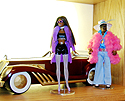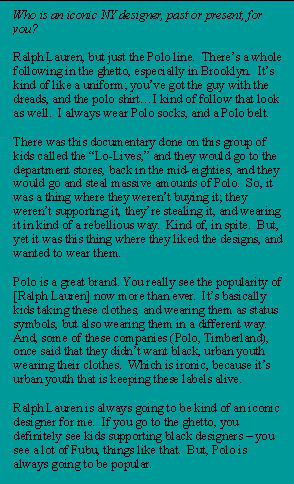 The Online Magazine about New York Designers |
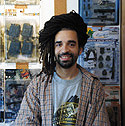
|
Jakuan El Haseem represents, for us, one of those "only in New York" possibilities. Transforming himself from the self-described ghettos of the Bronx to sought after designer in Japan, he really hasn't uprooted that much at all; he's still a New York creation. Jakuan's store, 360 Toy Group, is an odd at first mix of hard to find action figures and his own clothing line. The lines include "Rock Hard," which he describes as mountaineering with a hip-hop twist, and "Oh, Snap!," a line of Tee shirts incorporating photographs by Ricky Powell, a cult favorite who has documented the rap and hip-hop scene for almost two decades. 360 is in one of our favorite neighborhoods (we
happen to live there): the Lower East Side. It's at once a showroom,
gathering place and, as you'll read, formerly much of the contents of
his living room. LG:
I know that you've made toys and you sell toys; you design clothes and
t-shirts, you design the graphics for the t-shirts. What did you start
with?
|
|
|
JEH: When I designed in my apartment, I had my drafting table in my apartment, I also had a lot, a lot of toys, just everywhere. For me, toys at first were very inspirational. LG…Me too! JEH: …They would bring me into a different realm of designing, and I'd look at toys and I'd see the way they were made, and their clothing, and so toys were a large aspect of me, designing, even before I got into the whole aspect of toy designing myself. And, that's a big reason why I opened a toy store as well, because it filled up my apartment. There was a point, where everything was displayed, and my floor was filled with soldiers and vehicles, and you had to step around everything… DB: …So the contents of this store used to be your living room… JEH: My walls were filled, thumbtacked with carded figure, and now I've gotten to a point where all of my toys are boxed up and stockpiled. |
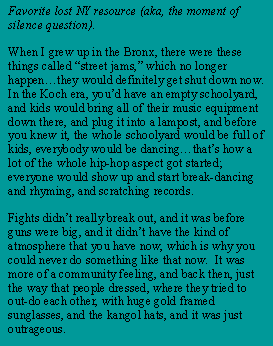 |
|
JEH: Definitely. DB: You spend a lot of time in Japan…is it mostly researching toys, buying things for your store, is it about the clothes… JEH: I have distributors in Japan for the clothing, that buy a certain amount per season, and it's their responsibility to spread it out in the good retail stores in Japan, so I go there a lot to meet with them, approve design, look at stores, things of that nature. DB: Are your designs sold here, or there? JEH: There, mostly. I'd say 95 percent. LG: It's interesting. Do you think it's about Japan's sensibility, or the way that the clothes are marketed there? JEH: It's very easy for someone like myself, to make it there, rather than here, because I'm from here. A lot of it has to do with the fact that I'm from New York, and a lot of it has to do with a certain market; a target market. I'm kind of a minority/street designer. DB: That's interesting to me, because your product sells largely over in Japan, but it's important that you be from here, and you actually work here, and it wouldn't make any sense for you to be working there. JEH:
New York does have a lot to do with me, [with] selling my work in Japan.
And the fact that I worked in clothing stores like Union and Surplus,
managing those shops, has a lot to do with it, because the Japanese
follow those type of markets, and they know who DB: So, are most of the toys bought in Japan, or are they from here? JEH: Well, both… DB: …It's interesting, because your trips to Japan are dual-purpose. JEH: …And it's also inspiration. Definitely multi-purpose. I do business over there, it's pleasure, but it's also inspirational. That's how I first got into collecting toys, going to Japan. DB:
So, while the inspiration for the toys is from Japan, inspiration of
the other things you work on, like the clothing, is from New York City?
|
||
LG: Do you ever collaborate with anyone? DB: One of the things that we are curious about are collaborations -- New York collaborations -- and how the collaborators met each other , how they came about. JEH: I've collaborated on the toys, on a new project: the Biggie Smalls and Tupac figures. I collaborated with a friend of mine named Masa, who is a sculptor. Those are the first two figures that we are trying to put out, and produce. We're working on licensing right now. I know Masa from Brooklyn, and mutual friends, for about eight years. Masa is like me; he pretty much does everything. He paints, he sculpts, he also does music, he's working on some music now in Japan. Like most of the people in my circle are artistic whether it's drawing or fine arts, or singing or dancing. DB: Does being in a community of so many designers influence your work? Is the design community a big part of your work? JEH: I'd say it's motivating, not influencing, especially when someone is successful, and being productive, and it shows, that motivates me. That's why I do what I do. A lot of it has to do with money, because of how we need to live in society, but a lot of it has to do with creating something and taking it from that thought to the actual finished product, and having people enjoy it. That's one of the main reasons that I do it. Let's say that a friend is having an opening of his work; that motivates me to get my stuff finished. As far as too many artists, well, everyone in their own way is an artist, whether they are smacking spoons on their knees…It's very motivating; everyone else sees the same things but it all depends on how you see it, which makes you the artist, which makes you more original or more creative. A lot of people tend to get influenced by other artists…but it's more motivated by what you see. It's how you take it and how you flip it.
|
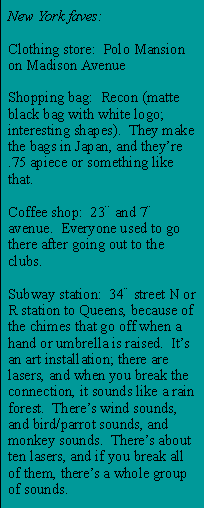 |

 lly
Japanese magazines, would approach me to do styling. They would want
me to style, say, a hip-hop section. That became a thing where I kind
of saw the market and saw what was out there and I saw what was missing
and I saw what people wanted, I saw what people were doing, what they
weren't doing, so I just decided to do something myself. And that's
what basically started me on clothing, and designing the graphics, and
then from there, it just turned into other things.
lly
Japanese magazines, would approach me to do styling. They would want
me to style, say, a hip-hop section. That became a thing where I kind
of saw the market and saw what was out there and I saw what was missing
and I saw what people wanted, I saw what people were doing, what they
weren't doing, so I just decided to do something myself. And that's
what basically started me on clothing, and designing the graphics, and
then from there, it just turned into other things. 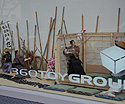


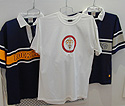
 I
am because of that. And that's why it was a little easier for me to
start something and cross over into clothing.
I
am because of that. And that's why it was a little easier for me to
start something and cross over into clothing. 
